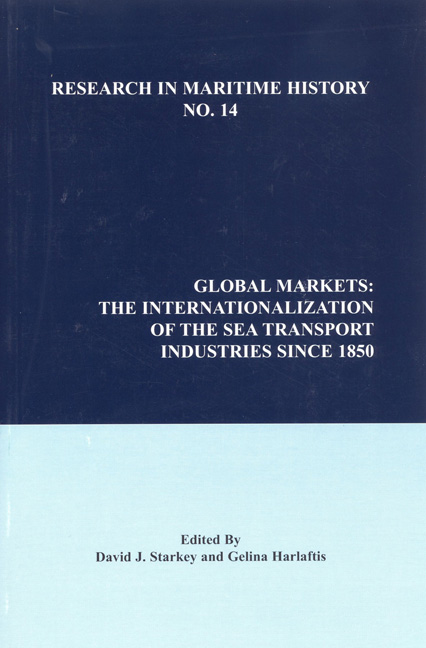Book contents
- Frontmatter
- Contents
- About the Editors
- Contributors
- Introduction
- “International Freight Markets in the 1830s and 1840s: The Experience of a Major Finnish Shipowner”
- “The First (and Very Secret) International Steamship Cartel, 1850-1856”
- “Competition or Co-operation in the Global Shipping Industry: The Origins and Impact of the Conference System for British Shipowners before 1914”
- “National Alliances and Global Webs: The Internationalization of Japanese Shipping”
- “Dutch Sea Transport in Transition: The German Hinterland as Catalyst, 1850-1914”
- “The Expansion of American Interests in Transatlantic Commerce and Trade, 1865-1893”
- “The Expansion of Japan's Shipping Interests before the Sino-Japanese War”
- “Cooperation and Reorganization on the North-South Routes from Japan in the Interwar Period”
- “The Global Communications Industry and Its Impact on International Shipping before 1914”
- “The Nineteenth-Century Roots of Globalization: Some Technological Considerations”
- “The Global Fish Market: Internationalization and Globalization, 1880-1997”
- “Convergence or National Styles? The Japanese Challenge to the British-Norwegian Hegemony in the Twentieth-Century Whaling Industry”
- “International Trends and Greek Shipping: The Business Strategy of Demetrios Moraitis, 1893-1908”
- “Organizational and Managerial Patterns of Greek- Owned Shipping Enterprises and the Internationalization Process from the Internar Period to 1990”
- “Internationalization and the Collapse of British Shipbuilding, 1945-1973”
- “Globalization and International Competitiveness: The Experience of the Japanese Shipping Industry since the 1960s”
- “Containerization and the Globalization of Liner Shipping“
“National Alliances and Global Webs: The Internationalization of Japanese Shipping”
- Frontmatter
- Contents
- About the Editors
- Contributors
- Introduction
- “International Freight Markets in the 1830s and 1840s: The Experience of a Major Finnish Shipowner”
- “The First (and Very Secret) International Steamship Cartel, 1850-1856”
- “Competition or Co-operation in the Global Shipping Industry: The Origins and Impact of the Conference System for British Shipowners before 1914”
- “National Alliances and Global Webs: The Internationalization of Japanese Shipping”
- “Dutch Sea Transport in Transition: The German Hinterland as Catalyst, 1850-1914”
- “The Expansion of American Interests in Transatlantic Commerce and Trade, 1865-1893”
- “The Expansion of Japan's Shipping Interests before the Sino-Japanese War”
- “Cooperation and Reorganization on the North-South Routes from Japan in the Interwar Period”
- “The Global Communications Industry and Its Impact on International Shipping before 1914”
- “The Nineteenth-Century Roots of Globalization: Some Technological Considerations”
- “The Global Fish Market: Internationalization and Globalization, 1880-1997”
- “Convergence or National Styles? The Japanese Challenge to the British-Norwegian Hegemony in the Twentieth-Century Whaling Industry”
- “International Trends and Greek Shipping: The Business Strategy of Demetrios Moraitis, 1893-1908”
- “Organizational and Managerial Patterns of Greek- Owned Shipping Enterprises and the Internationalization Process from the Internar Period to 1990”
- “Internationalization and the Collapse of British Shipbuilding, 1945-1973”
- “Globalization and International Competitiveness: The Experience of the Japanese Shipping Industry since the 1960s”
- “Containerization and the Globalization of Liner Shipping“
Summary
With minimal scope an account of internationalization in shipping could address a rather confined area such as transport between Britain and France across the English Channel or between Britain and the Iberian Peninsula. The latter example, of course, would cover only the “P” (Peninsular) in the P&O. To include the “O” (Oriental) the account would have to encompass Asia. These cases represent spatial variables of international experience. Internationalization, however, is more than just a geographic phenomenon, that is, the rapid spatial spread of shipping throughout the globe from 1850 onwards. The sub-title of this volume, “Internationalization of Sea Transport Industries since 1850,” also contains certain underlying temporal assumptions. It suggests that internationalization was a process of becoming or of ongoing evolution, and implies that there was less of an international phenomenon before 1850 than after and that its scale subsequently increased. The process of becoming can be examined by asking what were the agents of internationalization, while the evolution can be assessed by identifying and analyzing the characteristics of its increased scale. The agents of this transition were all related to two large themes: technology and investment. This proposition occupies the first section of the present chapter.
The second section addresses the characteristics of evolving internationalization, particularly with respect to Japan and with illustrations drawn partly from the experience of the Nippon Yusen Kaisha (NYK). In late twentieth-century parlance the term “international” has come to connote the sense of “global,” the other operative word in this volume's title. Indeed, the two words are often used interchangeably, as they often convey the same meaning. Yet, literally and thematically there are clearly important distinctions. The term “international” is ultimately rooted in the concept of the nation state and applies to relations between states as defined within Europe by the Westphalian system from the mid-seventeenth century or by the national aspirations of states in Asia within the framework of the Chinese tribute system. The term “global,” on the other hand, suggests an essentially trans-national phenomenon.
The contrast drawn here reflects two basic thematic ways of defining “international.” The first, reflecting the lingering effects of mercantilism, concerns relations between networks of different nations interacting in the form of commercial diplomacy and competing for market share on a global basis.
- Type
- Chapter
- Information
- Global MarketsThe Internationalization of The Sea Transport Industries Since 1850, pp. 81 - 102Publisher: Liverpool University PressPrint publication year: 1998



